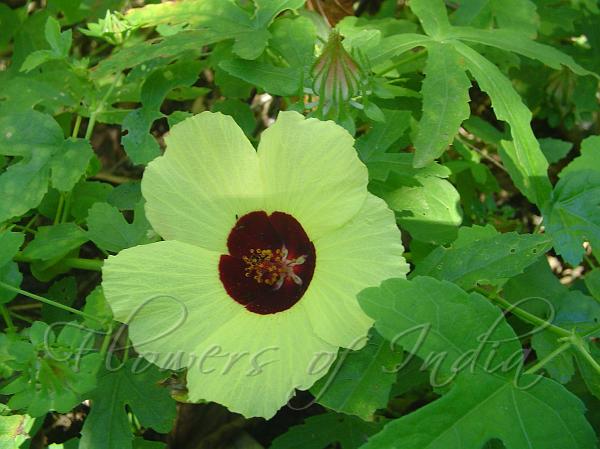|
| Bush Sorrel |
|

|

| File size | 292426 |
| Original date | 11/11/08 11:28 AM |
| Resolution | 2048 x 1536 |
| Flash | Flash did not fire |
| Focal length | 6.3mm |
| Exposure time | 1/125s |
| Aperture | 3.8 |
| Focus Distance | |
| Metering Mode | Multi-segment |
| Camera make | SONY |
| Camera model | DSC-P52 |
| Sensor type |
|
|
|
|
Photo: |
Botanical name: Hibiscus surattensis Family: Malvaceae (Mallow family)
Synonyms: Furcaria surattensis
Synonyms: Furcaria surattensis
Bush Sorrel is a weak-stemmed, prostrate or climbing plant covered with
soft hairs and scattered prickles. The leaves are rounded, up to 10 X 10
cm, and deeply and palmately 3- to 5-lobed, the lobes being toothed. The
flowers are yellow, with a dark center, and occur singly in leaf axils.
Petals are obovate, up to 6 cm long and 4 cm wide. This flower can be
easily identified by its unique false sepals, which are 8-10 in number.
The false sepals (actually bracts) are forked into a spoon-shaped outer
part, and a narrow linear inner part. But for this feature, the plant can
be confused with Deccan Hemp.
The capsules are hairy and ovoid. The seeds are downy. Bush Sorrel is found
throughout the tropical world. Its leaves are commonly used as pot-herb
in many parts of Africa and Asia. Flowering: September-March.
Medicinal uses: in Senegal the plant is used as an emollient.
Watt and Breyer-Brandwijk report that the Zulus use a lotion of the leaf
and stem for the treatment of penile irritation of any sort, including
venereal sores and urethritis. It is sometimes applied as an ointment
for the same purposes. An infusion is also used as an injection into
the urethra and vaginafor gonorrhoea and other inflammations.
in Senegal the plant is used as an emollient.
Watt and Breyer-Brandwijk report that the Zulus use a lotion of the leaf
and stem for the treatment of penile irritation of any sort, including
venereal sores and urethritis. It is sometimes applied as an ointment
for the same purposes. An infusion is also used as an injection into
the urethra and vaginafor gonorrhoea and other inflammations.
Medicinal uses:
 in Senegal the plant is used as an emollient.
Watt and Breyer-Brandwijk report that the Zulus use a lotion of the leaf
and stem for the treatment of penile irritation of any sort, including
venereal sores and urethritis. It is sometimes applied as an ointment
for the same purposes. An infusion is also used as an injection into
the urethra and vaginafor gonorrhoea and other inflammations.
in Senegal the plant is used as an emollient.
Watt and Breyer-Brandwijk report that the Zulus use a lotion of the leaf
and stem for the treatment of penile irritation of any sort, including
venereal sores and urethritis. It is sometimes applied as an ointment
for the same purposes. An infusion is also used as an injection into
the urethra and vaginafor gonorrhoea and other inflammations. | Identification credit: Tabish | Photographed in Mizoram. |
• Is this flower misidentified? If yes,